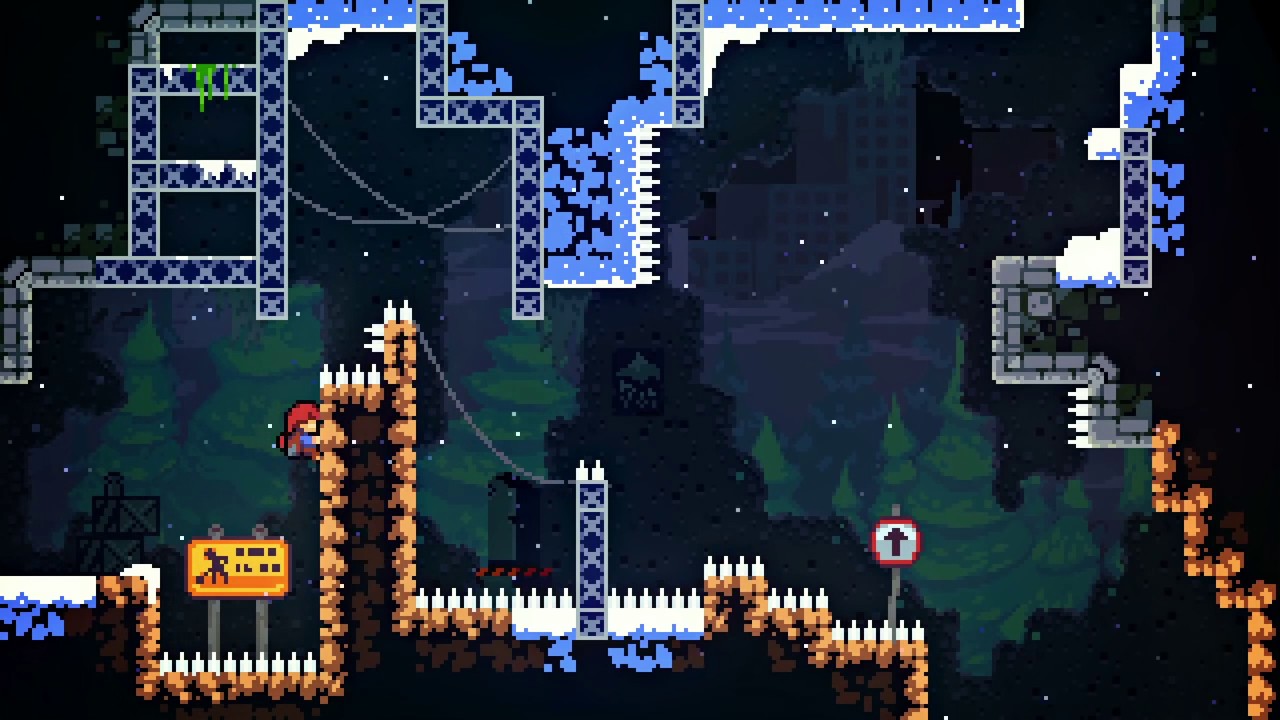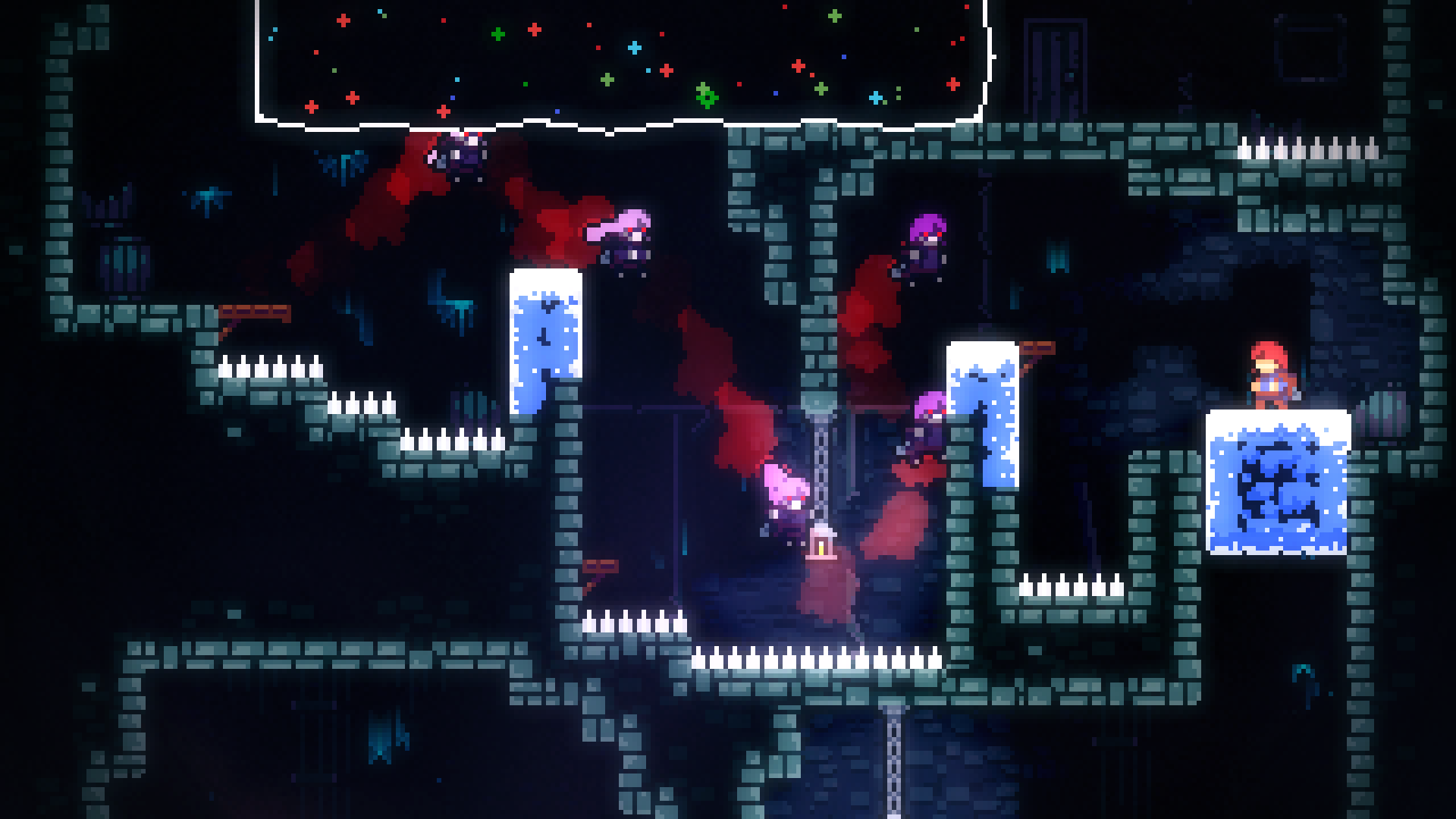Search
[{{{type}}}] {{{reason}}}
{{/data.error.root_cause}}{{{_source.title}}} {{#_source.showPrice}} {{{_source.displayPrice}}} {{/_source.showPrice}}
{{#_source.showLink}} {{/_source.showLink}} {{#_source.showDate}}{{{_source.displayDate}}}
{{/_source.showDate}}{{{_source.description}}}
{{#_source.additionalInfo}}{{#_source.additionalFields}} {{#title}} {{{label}}}: {{{title}}} {{/title}} {{/_source.additionalFields}}
{{/_source.additionalInfo}}Celeste (Switch)

Celeste
Developed by: Matt Makes Games
Published by: Matt Makes Games
Released: January 25th, 2018
Available on: macOS, PS4, Switch(Reviewed), Windows, Xbox One
Genre: Adventure, Platforming
ESRB Rating: Everyone 10+
Number of Players: 1
Price: $19.99
(Humble Store Link)
*Note - This review was written before the free DLC was released featuring gay/trans pride flags*
Video games are a complicated type of media for storytelling. It’s nearly impossible to make the gameplay and story work harmoniously; most games try to create a great story and great gameplay, then mash the two together. In most cases, little would be lost story-wise from telling the game’s tale in a book or movie. However, there is the rare title that masterfully crafts the gameplay such that it tells the story, and allows for few spoken words. Celeste is one of those games, which couples mental healing with platforming that gets extremely challenging, to put it lightly. But what makes the story and gameplay flow so well?
Celeste is a story about overcoming mental illness. Madeline, a Canadian young adult, wants to climb Celeste Mountain in order to prove something, though she isn’t initially sure what that is. The mountain is infamous for changing people’s lives, but it’s not immediately apparent why. After meeting an old woman who teases Madeline about her ambitions, Madeline begins her climb. She soon meets another traveler, Theo, who quickly becomes a significant character in the story. The initial climb is tough, but Madeline makes it, and soon discovers why the mountain changes people. As she approaches a mysterious mirror, Madeline’s negative traits are physically manifested into Badeline, who serves as the main antagonist for most of the game. Nevertheless, Madeline continues her climb.
I’ll openly admit, I didn’t expect Celeste‘s story to be so moving, considering that a good story is atypical, if not unheard of, in the genre. So, having such a great story was quite surprising. In terms of dialogue and cutscenes, the game is relatively thin, yet it makes the most of the interactions present. All the characters felt important to Madeline’s quest and were well developed. Theo’s character helped serve as a foil and secondary protagonist to Madeline, while Mr. Oshiro and the old woman served as the knowledgeable and mysterious elders. The way Madeline’s conversations with these characters change as the game progresses is a story in itself, as it shows her overcoming depression and becoming stronger as a result. Celeste‘s story is the best the genre has to offer due to the parallels of the figurative and literal.
The story also ties in to gameplay. Celeste isn’t needlessly hard; its difficulty serves as an obvious metaphor. Games like Super Meat Boy seem to just be hard for the novelty of it, whereas Celeste‘s reasoning makes it much more appealing to play for me. Of course, everyone is different, but the story isn’t obstructive to the gameplay, so it ends up being a win-win scenario for the designers. You can skip all the dialogue and story if you wish, which may be what some prefer to do (though I don’t recommend it).

Strong Points: Interwoven story and gameplay; Emotional, beautiful soundtrack; Stellar pixel art
Weak Points: None
Moral Warnings: Cartoon Violence; One use of the word "h*ll"
Celeste‘s gameplay is centered around getting from point A to point B on a screen, but this is much harder in practice, of course. Every hazard will instantly kill Madeline, sending her back to the beginning of the screen. Madeline can move left and right, jump, climb and use a dash. The dash can be used once in the air or on the ground as many times as desired, and is the primary interaction with the new objects in each stage. Climbing is intuitive: Madeline can latch on to a wall she faces, but she can only climb for so long before becoming fatigued. Standing on a platform allows Madeline to regain her dash and lose her fatigue. Naturally, having two of the main movement options centered around solid ground means that often the challenge of the game is simply to reach a platform before Madeline loses her grip and plummets to her death.
Celeste manages to create entertaining, challenging stages, each differentiated by certain techniques required for completion. These are always taught in a safe environment, but quickly require mastery for progression through the stage. There are a plethora of techniques to learn, but none overstay their welcome. The gimmick of each stage is self contained, which keeps gameplay fresh as opposed to convoluted. If one is playing a variation of Golden Ridge, for example, they can expect tangible clouds, high wind speeds, and green dash bubbles, which can be found nowhere else. Of course, the reaction abilities and movement skills developed throughout the course of the game serve as a unifying factor by being applicable everywhere, but each level is guaranteed to have its own twist on things.
One benefit of this localized system is the aforementioned lack of chaotic gameplay and focus on skills, and the other is just as important. If you don’t find a stage’s technique particularly enjoyable, you can simply avoid it! I didn’t like the cloud bouncing, but I didn’t need to worry about impacting the rest of the game since it would stay within a single level. Plus, keeping each stage isolated means that the harder B-side and C-side variations of the stage can make the most out of the techniques present. Instead of saving the hardest dash platform challenges for the final level, they can be present in level 5-C, making each challenge variation memorable in its own way.
Celeste greatly benefits from allowing player choice. Instead of forcing players to complete a linear series of challenges, the developers took the Super Mario Odyssey approach: when comparing the difficulty of challenges, the easiest 25% are the main story paths, while the intensity quickly increases in side content. The main story isn’t going to be a breeze for the best players either; there are 175 strawberries to collect, often sequestered behind a challenging screen. It’s great that even the main story has difficulty levels that can be created for yourself, since many games simply say that disgruntled top level players should simply wait for post game challenges. There’s even more than the strawberries, like the aforementioned B and C-sides. In each level of Celeste’s main story, there is a hidden challenge room containing a B-side cassette at the end of a rhythm based challenge. The B-sides use the same visuals and concepts as the A-sides, but are much harder. It’s somewhat like an alternate reality. If B-sides are still too easy, the C-sides for each stage unlock after finishing all the B-sides. There is also an 8th stage, called The Core, which has multiple prerequisites to play its A, B, and C-side. If all that isn’t enough, there’s also the golden strawberries, which require the player to beat an entire stage in a single run, or, in one case, beat a stage without dashing. This last challenge is infeasible to all but the most devoted, so I personally consider it a bonus as opposed to an actual goal. Also, the developers have announced that some farewell stages are coming soon. Whether these are D-sides or whole new levels, they were described as “very hard” by Matt Thorson, the game’s director, so I have high expectations. Clearly, Celeste has something for everyone with its level design, and that is both admirable and reasonable.

Higher is better
(10/10 is perfect)
Game Score - 98%
Gameplay - 20/20
Graphics - 9/10
Sound - 10/10
Stability - 5/5
Controls - 5/5
Morality Score - 94%
Violence - 9/10
Language - 8/10
Sexual Content - 10/10
Occult/Supernatural - 10/10
Cultural/Moral/Ethical - 10/10
No review of Celeste would be complete without touching on the presentation. As expected, the music and visuals are stellar as an individual entity and add to the narrative about mental health. Each stage in Celeste has a piece, which has a variety of movements that coincide with the events of the chapters. This makes the music dynamic, and enjoyable to listen to with or without the game. This variation also lets Madeline’s mood and feelings be expressed, which is important to the story, of course. The fast tempo of a chase scene leading into a moment of peace adds so much to the game, and makes the tracks memorable. In fact, I am contemplating buying a copy of the album, an honor reserved for only the best soundtracks. The B-sides have remixed versions of these tracks, arranged by guest composers. This makes each stylistically distinct, but the originals are still great.
Celeste, like many other games, has a pixelated style, but that doesn’t stop it from being unique. The design of every character, trap, platform, and background is polished, and often breathtaking. From the snowy industrial scenes of the Forsaken City, to the joyous sunsets in Golden Ridge, every sight is visually pleasing. Like the music, the visuals change with the mood, magnifying its effect. When a brief ray of sunshine (literally and figuratively) glimmers down on the player, it’s a moment of jubilation, as the worst has passed. I loved the distinct styles of Celeste‘s presentation, and it will forever stick out in my memory.
Celeste doesn't have many moral issues, even though it is a story about mental health. Madeline's deaths are simply shown as explosions of color, so it isn't very graphic. At one point, the word "h*ll" is used, but that is it for the language.
Celeste is a masterpiece. Everything can be enjoyed at different levels; people can be analytical of it, or simply just play for the platforming. No matter how you derive enjoyment from it, Celeste won’t disappoint. The story is endearing, interwoven, and help people understand what the depressed must cope with and how they overcome it. This game shows how powerful of a literary tool video games are, not just an interactive movie. Climbing a mountain is one large metaphor, so it’s no wonder that everything in the game fits together like a jigsaw puzzle. Even if you play just for the challenge of the platforming, you’ll understand Madeline’s struggle, and through that, the story. It’s impressive how well Madeline’s depression and how she overcomes it is portrayed, since even those who never had struggles mentally will be able to sympathize will her. The soundtrack and visuals only further improve the game, exponentially increasing the impact of the story. Although everyone has their own preferences when it comes to video games, Celeste is a title everyone should play, and those who choose to will certainly adore it.








